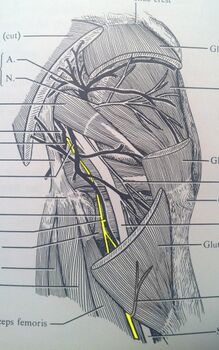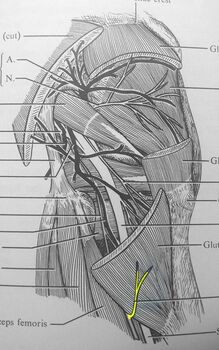What Presses on the Femoral Cutaneous Nerve When Laying on Your Back
Posterior Femoral Cutaneous Nerve
Jump to:navigation, search
Introduction [edit | edit source]
The posterior cutaneous nerve of the thigh, also known as the posterior femoral cutaneous nerve, is a sensory nerve derived from the sacral plexus. It supplies the skin of the posterior thigh, buttock, posterior aspect of the scrotum or labia and a variable area of the posterior calf [1].
Structure & Origin [edit | edit source]
The fibers contributing to the posterior cutaneous nerve of the thigh arise from the posterior divisions of the anterior rami of the S1 and S2 nerves, and the anterior divisions of the anterior rami of nerves S2 and S3 [2].

Posterior femoral cutaneous nerve
The nerve first appears lateral to the anterior sacral foramina, positioned underneath the psoas muscle's parietal pelvic fascia. It exits the pelvis inferior to the piriformis muscle via the greater sciatic foramen.
Course [edit | edit source]
After exiting the pelvis via the greater sciatic foramen, the posterior cutaneous nerve of the thigh travels with the Inferior Gluteal Artery deep to the gluteus maximus, overlying the sciatic nerve. It descends down the posterior thigh towards the back of the knee, deep to the fascia lata and superficial to the the biceps femoris (long head). Once the nerve reaches the popliteal fossa (posterior knee), it pierces through the deep fascia and travels towards the first half of the posterior leg with the Small Saphenous Vein. Its terminating branches connect to the sural nerve.
Branches & Supply [edit | edit source]
The posterior femoral cutaneous nerve of the thigh gives off three cutaneous branches. The branches are dispersed to the region of the buttock, the perineum and to the posterior thigh and leg.

Gluteal branch (Inferior cluneal nerve)
- The gluteal branch, aka the inferior cluneal nerve (originating from posterior divisions of the S1 and S2 anterior rami), travels upward around the inferior boarder of the gluetus maximus muscle to supply the skin overlying the inferior and lateral aspect of the buttock.
- The perineal branch courses medially between the gracilis muscle and the fascia lata to supply the skin located over the proximal and medial aspect of the thigh. The perineal branch also supplies the posterior aspect of the labia majora or scrotum.
- The nerve branch supplying the cutaneous distribution of the posterior thigh gives off perforating branches for cutaneous innervation as it courses inferiorly between the hamstrings and fascia lata, innervating the skin over the posterior thigh. It also provides cutaneous innervation to the skin over the medial thigh, popliteal fossa and sometimes the proximal aspect of the posterior leg. It can terminate as low as the area of the inferior gastrocnemius muscle belly over the mid-calf.
Relations [edit | edit source]
The inferior gluteal artery and nerve are in close proximity to the posterior femoral cutaneous nerve as these structures exit the greater sciatic foramen, inferior to the piriformis muscle and superior to the sciatic nerve. Furthermore, other structures also travel inferior to the piriformis muscle, including the nerve to obturator internus, the pudendal nerve and the internal pudendal artery.
Anatomical Variants [edit | edit source]
Occasionally, the S4 nerve root can contribute to the posterior femoral cutaneous nerve. According to one study, the posterior femoral cutaneous nerve has been discovered as a coupled structure in 18% of cadavers [3].
[edit | edit source]
It is possible that pain attributed to pelvic pathology can refer to the posterior thigh, and may be confused with other pathology such as sciatica. This is because the posterior femoral cutaneous nerve shares the same S2/3 nerve segments as the parasympathetic nerve fibers that contribute to the pelvic splanchnic nerves. The posterior femoral cutaneous nerve may play a role in pelvic pain syndrome [4].
References [edit | edit source]
- ↑ Moore KL, Dalley AF. Clinically oriented anatomy. Lippincott williams & willkins; 1999
- ↑ Dumitru D, Nelson MR. Posterior femoral cutaneous nerve conduction. Archives of physical medicine and rehabilitation. 1990 Nov 1;71(12):979-82.
- ↑ Windhofer C, Brenner E, Moriggl B, Papp C. Relationship between the descending branch of the inferior gluteal artery and the posterior femoral cutaneous nerve applicable to flap surgery. Surgical and radiologic anatomy. 2002 Dec 1;24(5):253-7.
- ↑ Tubbs RS, Miller J, Loukas M, Shoja MM, Shokouhi G, Cohen-Gadol AA. Surgical and anatomical landmarks for the perineal branch of the posterior femoral cutaneous nerve: implications in perineal pain syndromes. Journal of neurosurgery. 2009 Aug 1;111(2):332-5.
What Presses on the Femoral Cutaneous Nerve When Laying on Your Back
Source: https://www.physio-pedia.com/Posterior_Femoral_Cutaneous_Nerve
0 Response to "What Presses on the Femoral Cutaneous Nerve When Laying on Your Back"
Post a Comment